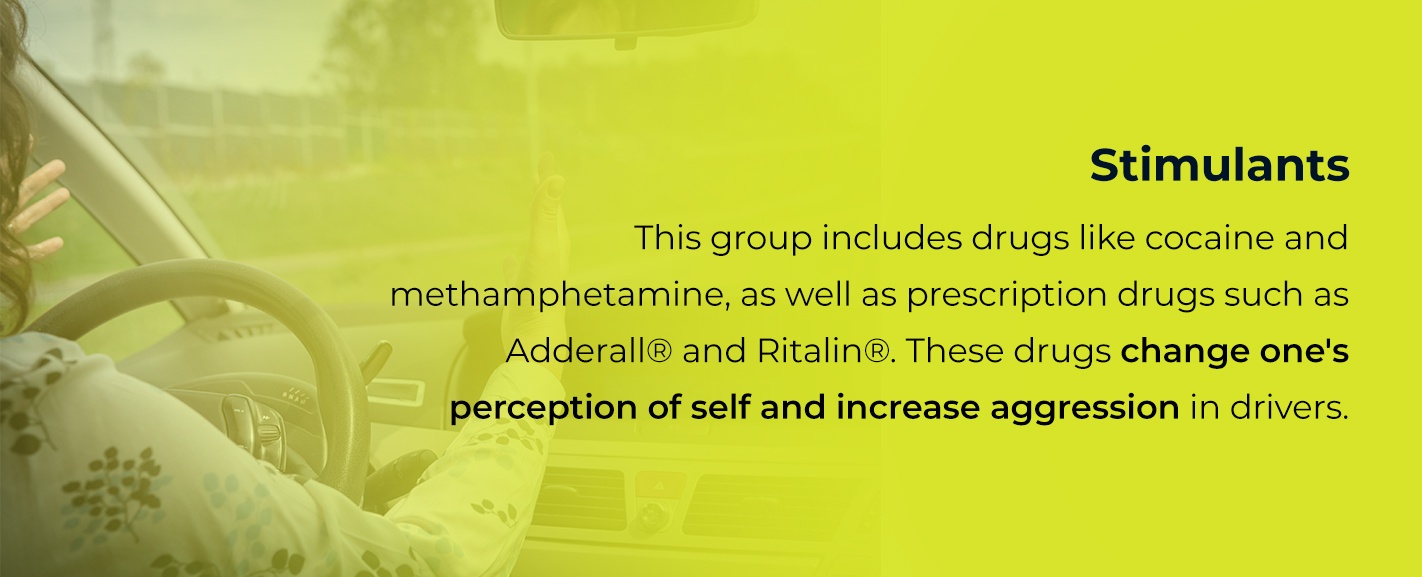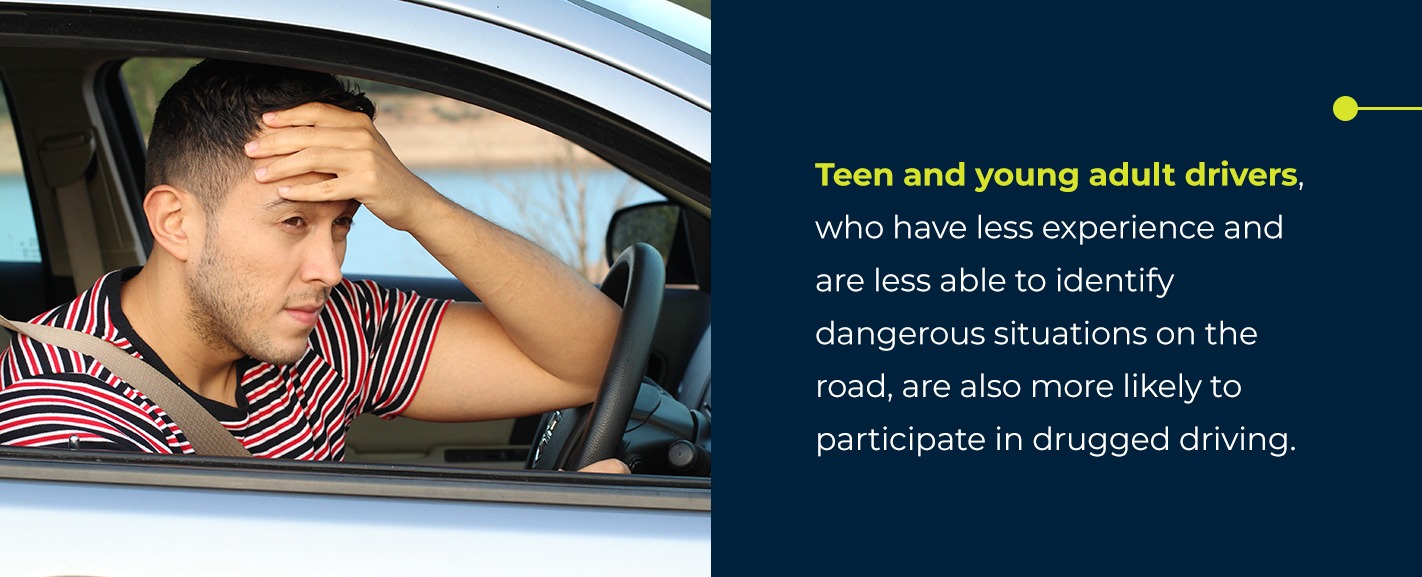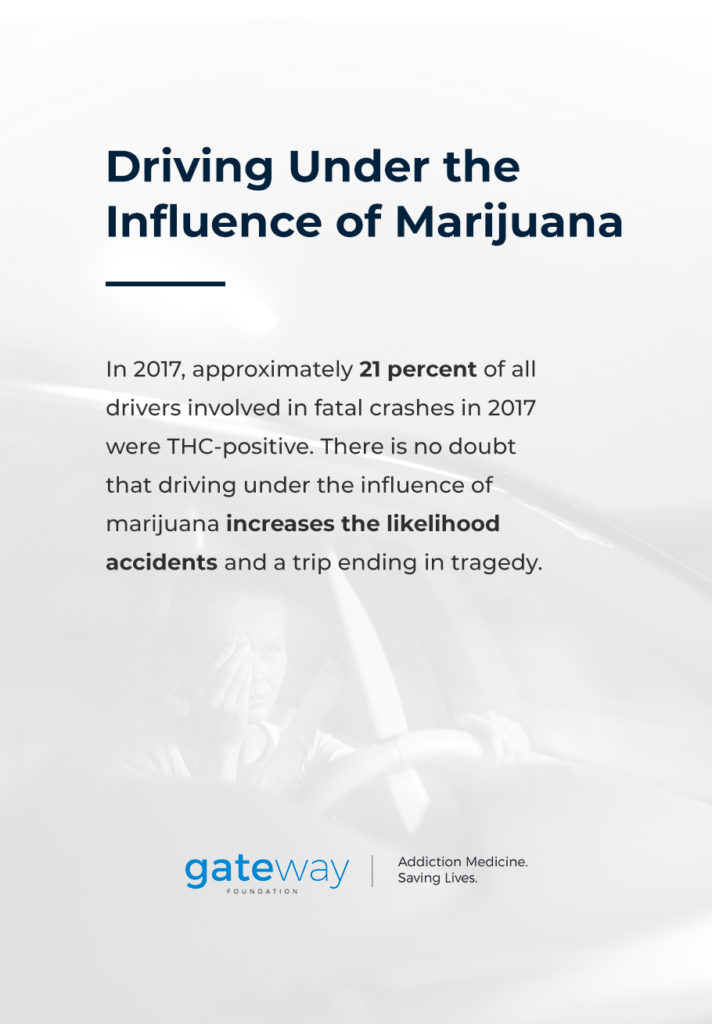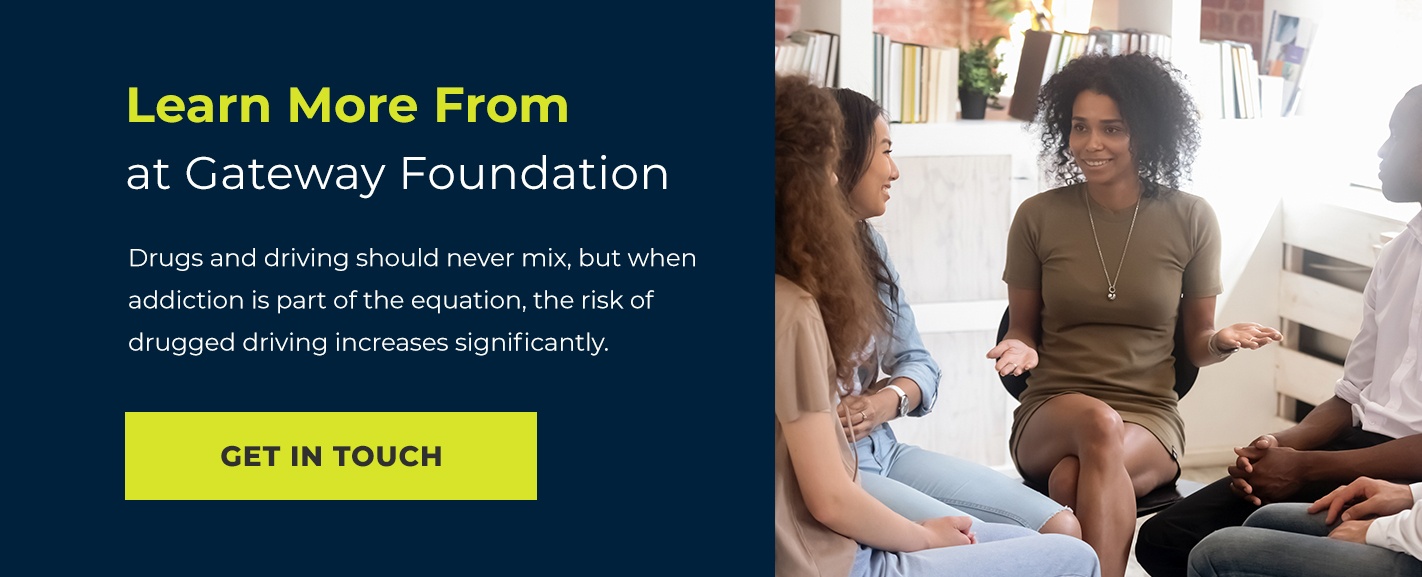- Dec 11
- Drug Addiction Treatment
Driving while under the influence of drugs is one of the most dangerous and irresponsible things a person can do — yet, it’s a phenomenon that occurs every day. The problem of drugged driving has been increasing in frequency and severity for many years, and understanding the scope of the issue is critical to personal and public safety.
- What Is Drugged Driving?
- What Substances Impair Driving?
- What Are the Effects of Drugs on Driving?
- How Is Drugged Driving Impairment Assessed?
- How Common Is Drugged Driving?
- Who Is at Risk for Drugged Driving?
- What Does the Law Say About Drugged Driving?
- What Are Some Strategies to Prevent Drugged Driving?
- Learn More From Gateway Foundation
In this guide, we’ll explain how prevalent the issue is and how different drugs affect drivers, so you can become a better advocate for safe driving.
What Is Drugged Driving?
Drugged driving is the act of operating a motor vehicle while impaired by the intoxicating effects caused by recent drug use. It makes driving extremely unsafe, just as drinking alcohol before driving does. When someone drives under the influence of drugs, they create serious risks for themselves, their passengers and anyone else on the road at the time.
What Substances Impair Driving?
Any substance that alters cognition can impair driving. In addition to alcohol, dangerous substances include illicit drugs like heroin or cocaine, legally-obtained drugs like opioid painkillers and still federally illegal cannabis. Here are some things to remember about the variety of substances that cause impairment:
- Many drugs, including marijuana, impair drivers by slowing down reaction times, reducing coordination and affecting judgment.
- Stimulant drugs like methamphetamine and cocaine cause drivers to be more reckless and aggressive while driving.
- Many prescription and over-the-counter drugs are known to cause extreme dizziness or drowsiness while driving.
- Polydrug use — the use of two or more drugs at the same time — results in impairment levels higher than the levels produced by individual drugs.
When a driver is impaired, he or she simply cannot assess the level of impairment accurately. When people feel different due to drugs, they drive different — and the only way to prevent drugged driving is to avoid driving after the use of any impairing substance.
 What Are the Effects of Drugs on Driving?
What Are the Effects of Drugs on Driving?
Each individual drug impairs a driver’s ability to conduct themselves safely in a variety of different ways. Some of the factors to consider are the class of the drug, the amount the person has consumed and the person’s prior experience using the drug in question. These are the most common classes of drugs used in accidents caused by people driving under the influence:
Alcohol
Alcohol is a type of depressant that, in even small amounts, can affect the skills and reaction times necessary to drive safely. Drinking too much and getting behind the wheel can impact the driver’s:
- Judgment
- Coordination
- Comprehension
- Concentration
- Depth perception
- Reaction time
- Peripheral vision
- Night vision
Benzodiazepines and Other Depressants
This class of drugs interacts heavily with the central nervous system (CNS), depressing its activity with a variety of side effects that make for extremely dangerous driving. The impairment effects of benzodiazepines include:
- Difficulty multitasking
- Impaired vision
- Slurred speech
- Drowsiness
- Impaired motor skills and coordination
- Slower reflexes
- Lowered inhibitions
- Impaired judgment
- Inattentiveness
- Reduced pupil reaction to light
- Involuntary eye movements
Stimulants

- An inflated sense of self-confidence
- Feelings of invincibility
- Reduced inhibitions
- Restlessness
- Nervousness
- Impaired spatial perception
- Inattentiveness
- Impatience
- Exaggerated reflexes
- Increased risk-taking
Hallucinogens
This drug class produces vivid auditory and visual hallucinations that are highly distracting in any setting. If someone takes a hallucinogen, such as LSD, before driving, they will have severe difficulty separating hallucinations from reality, leading to poor decision-making and unexpected reactions on the road. Overall symptoms of hallucinogen use include:
- Confusion and disorientation
- Slurred speech
- Trembling
- Impaired perception of time and distance
- Slowed reaction time
- Impaired cognition and difficulty focusing
- Impulsivity
Opioids
No matter whether they were obtained legally or illicitly, opioids have the same range of effects on driving. The type of opioid and its potency affect the extent of impairment, but someone who uses an opioid can expect:
- Runny eyes and nose
- Sweating
- Impaired ability to follow instructions
- Impaired coordination
- Sedation and sleepiness
- Slowed reflexes and reaction times
Cannabis
Driving under the influence of cannabis is often viewed as less dangerous than doing so after consuming other drugs. However, given the range of effects that can impair driving, that is clearly not the case. Cannabis causes:
- Dry, red eyes
- Confusion and disorientation
- Increased appetite
- Increased pulse and blood pressure
- Fragmented thought patterns
- Inattentiveness
- Excessive relaxation
- Drowsiness or sleepiness
- Memory lapses
- Impaired perceptions of time and distance
- Slowed reaction times
Driving Under the Influence of Alcohol
According to the National Highway Traffic Safety Administration, roughly one-third of all traffic-related deaths involve drunk drivers. That means every 50 minutes someone dies in an accident with a drunk driver, taking nearly 30 lives every single day.
In the United States, it is illegal to drive with a blood alcohol concentration (BAC) higher than 0.08% — except in Utah, where the limit is 0.05%. Individuals with a BAC of 0.10% or higher are seven times more likely to end up in a fatal accident than someone driving while sober.
Your BAC depends on all sorts of factors, from your age and gender to your weight, health and how efficiently your liver processes alcohol. On average, if a 160-pound person drinks two 12-ounce beers in an hour, their BAC would be 0.04% — roughly half the legal limit. Even though they aren’t legally drunk, they’re still 1.4 times more likely to crash when they get behind the wheel.
Setting a legal limit for drunk driving gives law enforcement something to work with, but it still sends a dangerous message — that as long as you’re not over the legal limit, it’s still safe to drive. This couldn’t be further from the truth. Drinking and driving do not mix — it’s as simple as that.
On average, a drunk driver will get behind the wheel 80 times before their first arrest. That’s 80 opportunities to get into an accident and 80 opportunities to take someone’s life because they chose to drive under the influence.
Driving Under the Influence of Marijuana
Unfortunately, many people believe incorrect misconceptions about cannabis and driving. Some people think that cannabis doesn’t cause significant impairment, while others even insist that the relaxing effects of the drug can actually make someone drive more safely — nonetheless, nothing could be further from the truth.
The spread of state-level legal cannabis laws means more people have access to marijuana than ever before. Currently, 11 states have legalized cannabis for recreational use and 33 states have medical marijuana programs. The proliferation of these laws has had a profound impact on drugged driving statistics involving cannabis. One survey conducted in Colorado determined that 69 percent of cannabis users reported driving under the influence of marijuana one or more times within the past year, and a shocking 27 percent admitted to driving high on an almost daily basis. Additionally, many of the recreational users indicated they did not believe cannabis impaired their ability to drive safely.
A 2016 report from Washington state makes it clear that this perception is both incorrect and extremely dangerous. The AAA Foundation for Traffic Safety discovered that after cannabis was legalized for recreational use, fatal crashes involving drivers with recent marijuana use more than doubled. In 2017, approximately 21 percent of all drivers involved in fatal crashes in 2017 were THC-positive. There is no doubt that driving under the influence of marijuana increases the likelihood accidents and a trip ending in tragedy.
How Is Drugged Driving Impairment Assessed?
It is relatively simple to determine the level of impairment in someone who has been consuming alcohol using a breathalyzer test. We have decades of research indicating that a blood alcohol content (BAC) of 0.08 percent is the threshold for impairment, and DUI laws are enforced accordingly. However, we do not have solid evidence of drug levels consistently correlating with clearly delineated impairment levels.
There are many variables that affect how drugs impair a person. If someone who has been using medical marijuana for years decides to get behind the wheel after smoking, they might display half of the impairment signs with twice the level of THC in their blood compared with someone who only smokes infrequently.
One of the suggested proposals for addressing cannabis-impaired driving has been to implement a blood THC limit of five nanograms per milliliter (ng/ml). However, the AAA Foundation for Traffic Safety found that 70 percent of cannabis-positive drivers arrested for driving under the influence has THC levels under five ng/ml. This indicates that the threshold is both arbitrary and too lax. Additionally, more than 75 percent of arrested drivers also tested positive for other drugs or alcohol, making it even more challenging to determine impairment levels.
Far more research is necessary to create specific and actionable profiles of cannabis and other drug impairment for consistent DUI enforcement.
How Common Is Drugged Driving?
The good news is that there has been a significant decrease in the number of drunk drivers. However, the number of people taking drugs and driving has increased to a worrying extent. The most recent survey on the subject was collected in 2016. The self-reported results revealed that 27.6 million Americans ages 16 and up drove under the influence of drugs or alcohol at least once. A further 10.7 million people drove while cannabis-impaired. This includes one in 10 drivers ages 16 to 20, for whom cannabis is illegal in all states.
The National Roadside Survey (NRS) is a tool used by the National Highway Traffic Safety Administration (NHTSA) that has only been conducted five times over the past 40 years due to its immense scope. The survey is both voluntary and anonymous, collecting information from 300 sites across the nation. The most recent NRS was conducted from 2014 to 2014. Some of its key findings include:
- The proportion of drivers with alcohol in their systems declined about 30 percent between 2007 and 2014, with an overall drop of 80 percent since the first NRS in 1973.
- In 2014, around 20 percent of drivers tested positive for one or more drugs, compared to 16.3 percent in 2007.
- About 12 percent of drivers showed evidence of marijuana use, compared to 8.6 percent in 2007.
- More than 15 percent of drivers tested positive for one or more illegal drugs in 2014, up from 12 percent in 2007.
The issue of driving under the influence of drugs (DUID) is clearly on the rise, despite efforts to curb the problem.
Who Is at Risk for Drugged Driving?

- About 24 percent reported drugged driving within the last year.
- About 25 percent of drugged drivers engaged in 10 or more instances of drugged driving in the past year.
- About 96 percent of drugged drivers reported driving after the use of marijuana.
Older adults are also susceptible to drugged driving, but they are most likely to be using prescription drugs. Mental decline may result in taking a prescription too frequently, not frequently enough or in the wrong dosage. Older adults may also take longer to eliminate drugs from their bodies than younger people, which can lead to accidental intoxication while driving.
What Does the Law Say About Drugged Driving?
With drugged driving on the rise, how does the law address this critical issue? There are three main categories of law that address driving under the influence of drugs:
1. Per Se and Zero-Tolerance Laws
Per se laws tie impairment to levels of drugs or metabolites present the body. The translation of “per se” is “in itself,” indicating that having a specific level of a substance present is enough to constitute a crime. Many states have zero-tolerance per se laws, meaning that having any level of illegal drugs or their metabolites in the body is a violation. When it comes to alcohol, all underage drinking is prosecuted similarly to illicit drugs under zero-tolerance laws because any alcohol consumption is illegal under the age of 21.
One of the arguments against zero-tolerance per se laws is that having a metabolite or drug in the body is not proof that a person is actually impaired. This is a problem mostly associated with cannabis, as its metabolites are detectable for days or weeks after the last use — long beyond the drug’s window of impairment.
2. Tandem Per Se DUID
As a way to address the problems associated with zero-tolerance laws for DUID, the American Automobile Association has suggested a new two-part structure that can more reasonably determine whether marijuana use has impaired a driver. The proposed system incorporates behavioral evidence of impairment, such as slow reflexes, poor coordination and slurred speech with physiological proof of impairment through drug testing for recent use. This framework increases certainty of DUID for the prosecution.
3. Administrative License Revocation
Currently, 42 states and the District of Columbia have administrative license revocation (ALR) laws for those caught driving under the influence of alcohol. If a driver refuses to take a breathalyzer test or fails the test, law enforcement officers can confiscate the individual’s driver’s license. The arresting officer can take the license right on the roadside, and the suspension or revocation is considered an administrative sanction rather than a criminal punishment. Multiple states have proposed extending these ALR laws to drugged driving once more accurate tests are developed.
What Are Some Strategies to Prevent Drugged Driving?
While law enforcement and a variety of organizations are working hard to inform the public about the dangers of drugged driving, there are also steps you can take to make sure you and the people around you aren’t contributing to drugged driving statistics. Some key tips include:
- Offer to be the designated driver.
- Collect all keys from people you know have been using drugs.
- Whenever you attend an event where drugs and alcohol are present, get a ride rather than driving yourself.
- Take the time to talk to your friends and family about the risks associated with drugged driving.
It’s important to remember that drugged driving isn’t just a problem with illicit drugs. If you are taking any over-the-counter or prescription medications, it’s your responsibility to thoroughly read all warning labels before taking the product and driving a vehicle. Take warnings not to operate motor vehicles seriously, and don’t drive if they are present. If you have questions about your medication, be sure to consult your pharmacist.
 Learn More From Gateway Foundation
Learn More From Gateway Foundation
Drugs and driving should never mix, but when addiction is part of the equation, the risk of drugged driving increases significantly. Gateway Foundation is dedicated to helping stop drug abuse with evidence-based addiction medicine and multiple therapy modalities.
To find out more about the effects of drugged driving and addiction, as well as how you or a loved one can seek healing through addiction treatment, call Gateway Foundation at 877.505.4673 or contact us online.

 What Are the Effects of Drugs on Driving?
What Are the Effects of Drugs on Driving?


